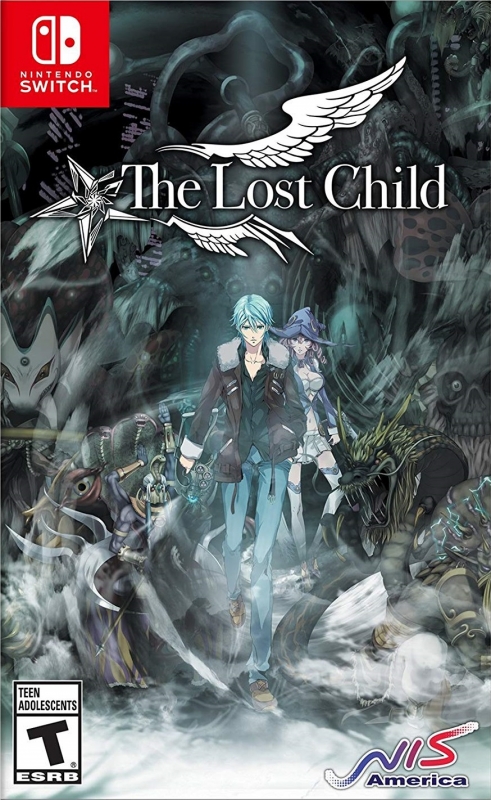Existing User Log In
New User Registration
Register for a free account to gain full access to the VGChartz Network and join our thriving community.





America - Front


America - Back

In the midst of a strange year, The Lost Child might be one of the strangest things of all. In fact, calling The Lost Child an odd game would be underselling it. A mix between turn based RPG and first person dungeon crawler, with adventure game-esque discussion segments spliced in between, sounds odd enough, but when you add in a cast of wacky characters, an underlying subplot about divine intervention and God’s will, and a truly outlandish artstyle, the game moves from merely odd to highly unusual. Strange isn’t necessarily bad, however, so once the initial presentation is over, how does The Lost Child hold up?

The story revolves around Hayato, who works as an occult photographer in the city until an angel wearing a robe and roughly a square foot of clothing beyond that shows up at his job one day and tells him that he’s been chosen by God for... something. It actually takes quite a while until we really get a sense of why Hayato in particular has been roped into this, and The Lost Child never seems to get tired of cutting away from him to characters elsewhere having mysterious discussions about secret plans with all the words carefully omitted to keep players in the dark as long as possible. I don’t think I’d normally mind a game keeping a mystery going, but if we’re going to consistently be taking the focus away from the player, I think there’s more the game could be accomplishing from a narrative standpoint besides going “tee hee we’ve got mysterious stuff you haven’t figured out yet.”
Gameplay is spread out between the aforementioned dungeon crawling and the discussion segments. Dungeon crawling is likely the most engaging part of the affair; even if it doesn’t take long to realize that every single dungeon is just a labyrinth of linear passageways, exploration is still fairly enjoyable. Combat is standard turn based RPG fare; regular physical attacks, special attacks that consume MP, items, the option to defend, etc. One new-ish inclusion is the ability to capture certain enemies when a gauge is built up and add them to your party, making them fight alongside you in future battles. This is implemented fairly well, and gives you the option to mix your party up routinely. Unfortunately, there just isn’t enough variety in the options beyond that to keep things engaging, especially considering there’s an extensive amount of grinding that players will likely need to do in order to survive in the endgame.

When you’re not busy being harassed by various tentacle monsters surprisingly capable at wielding spears for creatures that appear to lack opposable thumbs, the adventure game-esque discussion portions come into play. Regrettably, however, they don’t do much more than simply waste player time. From a design standpoint, discussion is pretty much entirely just pressing the conversation button enough times until the game allows you to progress, and it doesn’t take long for the various cast of “wacky” standard anime stereotype NPCs to get wear out their welcome. It’s also a bit disappointing that the game doesn’t use the opportunity to do a bit more world building in these segments, especially given how many of the intricacies involving this seeming war between angels and demons are never really elaborated on. The only thing these segments really manage to do is demonstrate that the city Hayato lives in is filled with a bunch of quirky people who all have surprisingly similar character models.
Arguably strangest of all is the game’s art style, which I still can’t fully decide if I like or not. There truly are some impressive looking character and enemy designs, even if only being able to view most of them the same direction limits some of the impact it can have. On the other hand, however, the game embraces pure absurdity from the get go and never lets up on the pedal, and after a while I found myself getting tired of looking at utterly bizarre mish-mashes of demonic limbs and people with cat heads. Perhaps much of the problem is that, in a world where everything appears as strange, strange-ness itself loses its impact after a while.

Get past the odd conversations, bizarre story, and curious artstyle, and The Lost Child’s greatest flaw becomes apparent; it is utterly unremarkable in nearly every facet besides the sheer “craziness” that is fit into it. Despite selling its conversation segments as a way for players to “hunt for clues,” no skill is required besides the patience to sit through all the largely unhelpful dialogue. The combat is competent JRPG afair and nothing more, and the dungeons are all mazes with little in the way of varied design to keep them interesting. A better narrative might have had a chance of keeping everything together, but even that gets to a point where it’s so consistently uncanny that it loses all impact. None of it is notably bad, but none of it is particularly good.
If it cost $15-$20, this might not be a deal breaker, but The Lost Child costs $50. Ultimately, the price point is probably the biggest sticking point; the game simply lacks either the production value or enjoyability to justify charging that much. It's certainly long (it’ll take you about 30-40 hours with minimal grinding and there’s an extra chapter to play through if you want), but the core gameplay runs out of tricks by about hour five. If you’re looking for a turn based JRPG to play through, there are far better options out there that provide more variety for your dollar.










| Total Sales |
0.00m
Japan |
0.02m
NA |
0.00m
Europe |
0.00m
Others |
0.03m
Total |
| 1 | n/a | 2,200 | n/a | 481 | 2,681 |
| 2 | n/a | 760 | n/a | 166 | 926 |
| 3 | n/a | 653 | n/a | 143 | 796 |
| 4 | n/a | 330 | n/a | 72 | 402 |
| 5 | n/a | 296 | n/a | 64 | 360 |
| 6 | n/a | 344 | n/a | 75 | 419 |
| 7 | n/a | 482 | n/a | 105 | 587 |
| 8 | n/a | 270 | n/a | 59 | 329 |
| 9 | n/a | 120 | n/a | 26 | 146 |
| 10 | n/a | 75 | n/a | 16 | 91 |